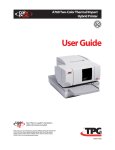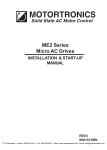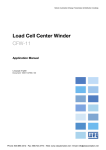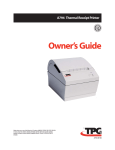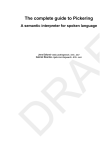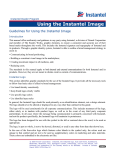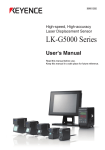Download MODEL # 610 - Parts Town
Transcript
M098 – REV B (JULY 2006) SERVICE MANUAL M098 MODEL # 610 CROWN OPENER Page 1 of 8 8/4/2010 M098 – REV B (JULY 2006) Model 610 Crown Can Opener SAFETY PRECAUTIONS WARNING! 1) Do not allow any person near knife or lid remover while machine is being operated. The fast, high forces of air cylinders that operate the blade and lid remover can cause serious injuries. The two hand controls and guards keep the operator away from these sharp, moving parts. Wear hand protection when handling knives, open cans and lids. 2) Always disconnect air while cleaning, repairing or adjusting. 3) Check knife for wear, cracks, dents or bent teeth that could cause metal slivers or food trap areas that are difficult to sanitize and could lead to sickness or internal injuries if can contents become contaminated. Replace or return to the factory for repair if damaged. 4) Inspect the machine before and after operating each day or shift and after any change or adjustment for: 1) Loose screws, 2) That the knock-out pins are straight and line up with holes in the blade backing plate and that the mounting screws are tight, 3) That all covers and guards are in place, 4) That there isn’t any broken welds and, 5) That the machine has been cleaned thoroughly. 8/4/2010 Page 2 of 8 M098 – REV B (JULY 2006) Blade Cleaning and Inspection CLEANING INSTRUCTIONS 1) Disconnect air supply. Remove guard ring, blade clip and knife and wash after use. Remove two knurled screws that hold the guard ring in place. It may be necessary to pull down on the guard ring to remove it if the locating pins are too tight. Support the blade with your hand, lifting slightly to loosen blade clip so it can be pulled out releasing the blade to drop out. These parts should be sanitized in a dishwasher. 2) Wash down with soap and water entire splash area around knife, guard ring and lid remover. 3) Entire machine can be washed. 4) Reassemble blade, blade clip and all guarding. Be sure all screws are tight. Reconnect air supply CAUTION! Keep water out of airlines especially when using pressure washers. Do not allow food to remain on machine. Dried food deposits are unsanitary and can damage valves, and cylinders. 8/4/2010 Page 3 of 8 M098 – REV B (JULY 2006) SETUP AND OPERATION 1) Unpack can opener and check for any loose screws or any damage. 2) Place can under the guard ring and against the locator. The can should be centered 3/16” under the ring. 3) Connect the airline. Air should be clean and dry (a 5 micron filter and coalescing filter are recommended). Air requirement is 1-2 CFM at about 85 PSI. The valves and cylinders are pre lubricated, so no lubrication is required. 4) Depress both palm buttons at the same time and hold until the lid is removed. 5) Remove can with both hands and remove the lid. Then the product can be dumped. Avoid sharp lid edges. 6) Replace opened can with another unopened can and start again. The Model 625 opener is factory adjusted to open a standard #10 can or the particular size can ordered. The crown punch should penetrate the can just far enough to cut off the cover but not so far as to cause excessive splashing of liquid in can. If an adjustment is required to improve operation of the opener, the following procedure will be used: CAUTION: To avoid personal injury, disconnect air line before making any adjustment. 1. Disconnect airline to unit. 2. Place can to be opened under can guard. 3. Loosen the four nuts or bolts at the rear of the vertical (see drawing) and raise or lower the head as desired, keeping the can and can guard aligned and level. 4. Tighten fasteners and close interlock door. Operate according to operating instructions. If a new size can is required to be opened, the following procedure will be used: 1. Disconnect airline to unit. 2. Hold up the knife guard ring with one hand and with the other hand unscrew the two thumb screws. (A flathead screwdriver may be needed to start the screws.) Let the guard ring down and place to the side. Now hold up on the knife with one hand (being careful of any sharp parts of the knife), and with the other hand, pull the blade clip straight out. (You may have to wiggle the knife to loosen the blade clip.) Let the knife down. Place knife and clip with guard ring. Do not let knife fall in the deck. 3. Install desired crown punch and can guard onto opener. 4. If can knockout pin does not align with holes in crown punch loosen screws holding them and rotate the pins until they line up with the holes in the knife. Tighten screws and mount the knife, clip and guard ring. If lid remains in knife, make sure knockout pins (P016) are in place and that knife is retracting all the way. 5. Place can to be opened under can guard. If new can is taller than former size can, loosen the four nuts or bolts at rear of vertical (see drawing) and raise head. 6. Place 1/8 –3/16 inch thick shim between can and can guard. 7. Level and align head and tighten fasteners at rear of vertical. 8. Operate according to preceding instructions. 8/4/2010 Page 4 of 8 M098 – REV B (JULY 2006) 610 Operation and Troubleshooting Operation Description 1. Place can in position against guard ring tab. There should be approximately 1/8" between the top of the can and the bottom of the guard ring. Adjust, if necessary, keeping the head level and spaced evenly. 2. Connect a clean and dry air supply set to about 85-psi pressure. 3. Depress both green buttons at the same time and hold down until blade hits the end of stroke and release. Lid should be completely separated from the can. Pneumatic Description The two green palm buttons (B138) are attached to one normally open (V005) and one normally closed 3-way air valve (V002). The output of these two valves is connected to the pilot actuators of a 5-way valve (V015S). The two outputs of the 5-way valve are connected to a 4" diameter air cylinder (C185), which is connected to a blade (A756), which removes the lid. Both buttons must be actuated to shift the 5-way valve and extend the cylinder and open the can. Releasing them shifts the 5-way valve back and retracts the air cylinder. Troubleshooting Only qualified maintenance personnel should do repairs. Symptom 1. Unit will not operate when buttons are pushed. 8/4/2010 a. Check air connection and supply pressure (air should come out of unit when it is disconnected). b. Remove cover to check valve operation. The valve (V005) connected to the right button should only let airflow through it when actuated. Remove the side hose by pushing in collar and pulling out the hose at the same time. Operating the button should let air out and releasing it should stop it completely. The other button and valve (V002) works just the opposite. If both valves are OK then remove the upper hose to the cylinder. Air should only come out of this hose when both buttons are pushed. If no, (V015S) is faulty and needs to be replaced. If it checks out OK, be sure cylinder is not filled with water or oil and hydraulically locked. With air disconnected and the hoses to the cylinder disconnected, the cylinder should be free to be pushed up and pulled down by hand. If it is seized up it needs to be removed and replaced or repaired. Page 5 of 8 M098 – REV B (JULY 2006) Symptom 2. Air leaks out around cylinder shaft near blade. The cover must be removed to pinpoint leaks. Worn seals usually cause cylinder end leaks and the cylinder must be removed and repaired or replaced. 3. Air leaks out the 5-way valve (V015S) exhaust. The valve (V015S) probably needs repair or replacing. Remove cylinder top hose to check if only the valve (V015S) is faulty. If cylinder piston seals are bad, air will come out of the top cylinder port. 4. Air leaks around one of the valves, V002, V005 or V015S. Check to be sure all connections are tight and hoses are pushed all the way on. If the three way valves are stuck or worn out they can leak around the actuating stem. Disassembly and cleaning is possible but replacement is recommended. 5. Blade goes down, but will not return. a. b. c. d. 6. Blade fails to open can completely. a. Inspect blade for damage – replace or return to the factory for reconditioning. b. To check cylinder stroke, hold both buttons down – blade should come down at least 1-1/2" to the points or 3/8" to the valley. Cylinder may be loose, binding or filled with water or oil and hydraulically locked, repair or replace as necessary. c. To adjust the head height – loosen bolts in back and adjust head to correct height or slightly closer being sure to keep the gap between guard ring and can even on both sides. d. If the lid is still attached near the front or back, check the gap there, excessive variation before operation or too much flexing during operation can be caused by a bent frame or broken welds (be sure knife is good and you have 85 psi of pressure). Return to factory for repairs if frame is damaged. 7. Lid does not fall out of knife. a. Bent or broken knockout pin. Repair or replace. b. Damaged blade holding the lid. Repair or replace. 8/4/2010 V002 valve stuck in and/or V005 valve stuck in and/or V015S valve stuck in open position and/or Cylinder (C185) seized in down position. Repair or replace factory parts. Page 6 of 8 M098 – REV B (JULY 2006) 610 PARTS LIST CO M P # A6 00 A6 01 A6 031 A6 035 A7 20 A7 56J A0 18 A0 19C A0 60 B1 3 2 B136M B1 3 7 B137B B1 6 3 C0 8 4 C1 0 5 C1 2 4 C1 3 7 C1 8 5 F0 0 3 F0 0 9 F0 1 8 F0 3 6 F0 3 3 F0 3 7 F0 3 8 F0 5 0 F0 5 2 H027 H028 K0 3 9 K0 7 5 L2 1 1 L2 1 2 L2 1 3 M 080 N008 N039 P0 1 6 P0 2 8 P0 4 2 R0 4 6 S0 2 6 S0 3 3 S0 4 9 S0 6 8 S0 8 4 S3 4 9 S3 5 0 S5 0 4 V0 0 2 V0 0 5 V0 1 4 V0 1 5 S W 010 W 013 W 021 W 024 8/4/2010 DESCRIPTION W e l d m e n t , Fr am e (A 7 4 9 , F0 5 2 [4 ], R0 2 1 , R0 4 6 , S2 2 3 ) W e l d m e n t , Ram Pl at e (G0 2 8 [2 } , P0 4 2 [4 ], P1 0 3 ) A ssy , M i lle r Cy l W / M o u n t On ly A ssy , A 6 0 3 1 Cy l. A ssy . W / Val v e (A lle n A i r Cy l. Re p l.) A ssy , # 1 0 6 0 3 Gu ar d Ri n g (Sp e c i f y Ot h e r Can Si ze ) A ssy , # 1 0 Kn i f e (Sp e c i f y Ot h e r Can Si ze ) A d ap t o r , Pu sh Bu t t o n A d ap t o r , Ram - Fo r Clip (A lle n A ir Cy l.) A d ap t o r , Sw iv e l Elb o w 1 /4 N PT t o 1 /4 " ID H o se Bu sh i n g , Re d u c t i o n 1 /4 t o 1 /8 " N PT Bu sh i n g , Sn ap - M o d i f i e d Bu t t o n , M u sh r o o m Pu sh Bu t t o n , Bu t t o n On ly Br ac k e t , # 6 1 0 Co v e r Cli p ,# 1 0 Re t ain in g (Sp e c if i y Ot h e r Can Si ze ) Co u p li n g , A ir #3 8 2 2 4 Co v e r , Fr o n t Co v e r , To p Cy li n d e r , 4 " x 1 5 /8 " N FPA si d e m o u n t W / A d ap t e r Fast e n e r , So u t h c o Fi t t i n g , 1 /4 " N PT Br an c h Fi t t i n g , Sw i v e l t o 1 /4 " ID H o se Fi t t i n g , Pu sh -i n 1 /8 N PT t o 1 /4 OD H o se Fi t t i n g , Pu sh -i n Sh o r t Elb o w 1 /8 N PT 1 /4 " OD Fi t t i n g , Pu sh -i n Elb o w 1 /8 N PT t o 1 /4 " OD H o se Fi t t i n g , Pu sh -i n Br an c h Te e 1 /8 N PT Br ass t o 1 /4 " OD Fi t t i n g , Pu sh -i n Fit t in g Elb o w 1 /4 N PT t o 3 /8 " OD Fo o t , # 6 1 0 /7 0 0 H o se , Cle ar 3 /8 " OD H o se , Cle ar 1 /4 " OD Kit , Ro d Bu sh i n g M i lle r Kit , St ar y l 1 " Ro d b u sh i n g Lab e l, W ar n in g " Kn i f e c u t H azar d " Lab e l, W ar n in g " Ke e p Gu ar d s i n Plac e " Lab e l, Cle an i n g In st r u c t i o n s M o u n t , C1 8 5 Cy li n d e r N i p p le , 2 " lo n g N u t , A -4 1 4 1 -3 /4 -1 2 Pin , Kn o c k o u t Pin , Ro ll Pin , W e ld Riv e t , SB 5 -6 Sc r e w , S/S 1 /2 - 1 3 x 1 " H e x Sc r e w , S/S 1 /2 - 1 3 x 3 /4 " H e x Sc r e w , S/S 1 0 - 3 2 x 3 /8 " H e x Sc r e w , S/S 1 0 - 3 2 x 1 /4 " RH M Sc r e w , 8 - 3 2 x 5 /1 6 " RH M St an d o f f , C1 8 5 Cy li n d e r Sc r e w , 1 /2 - 1 3 x 2 FH S Sc r e w , S/S 4 m m x 1 0 F.H . Slo t t e d Valv e , 3 -w ay N .O. Valv e , 3 -w ay N .C. Valv e , Old M ac 9 2 1 B-RA Valv e , 5 -w ay SM C W ash e r , S/S # 1 0 Flat W ash e r , S/S 1 /2 Flat W ash e r , S/S # 1 0 Lo c k W ash e r , S/S 1 /2 Lo c k Page 7 of 8 M098 – REV B (JULY 2006) EDLUND CO. INC. 8/4/2010 Page 8 of 8








